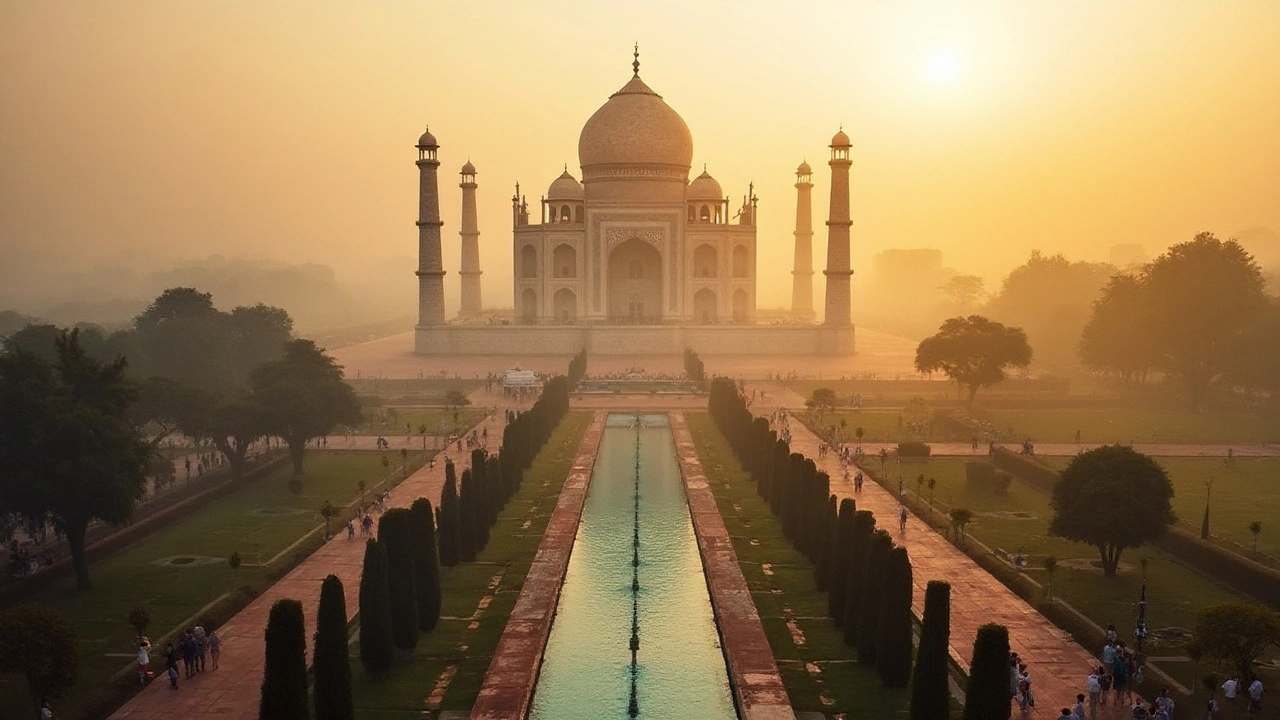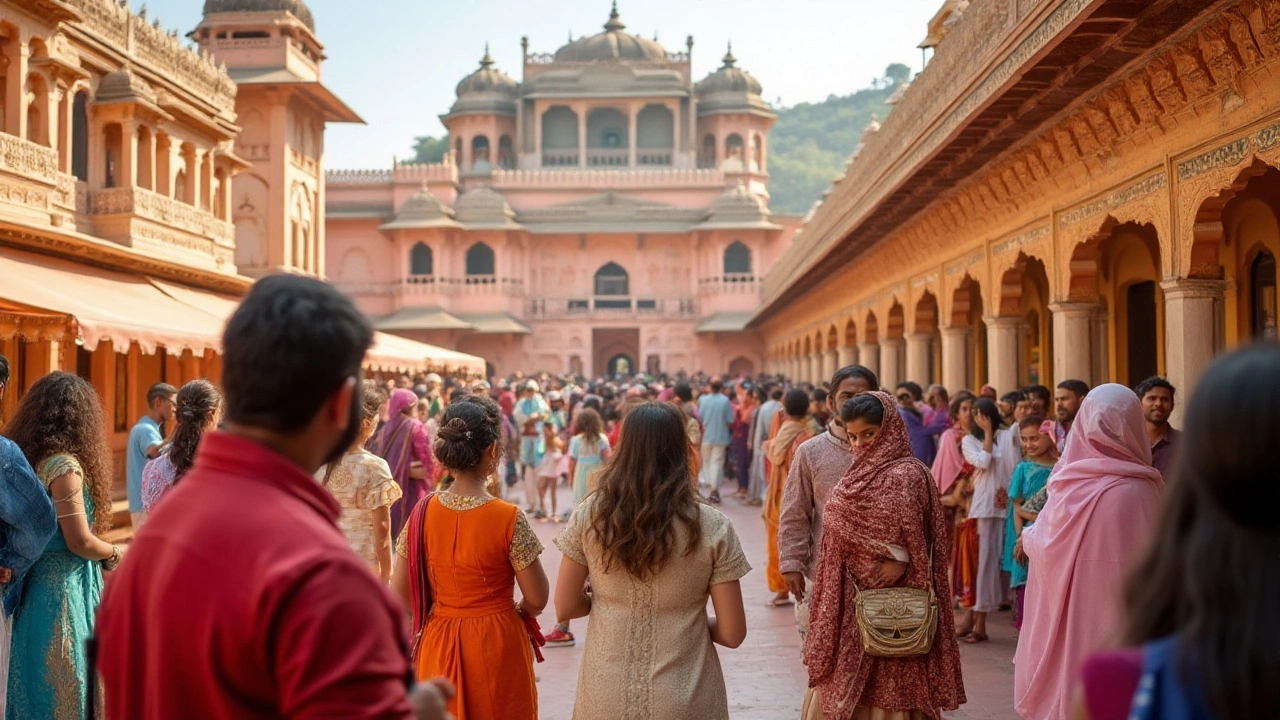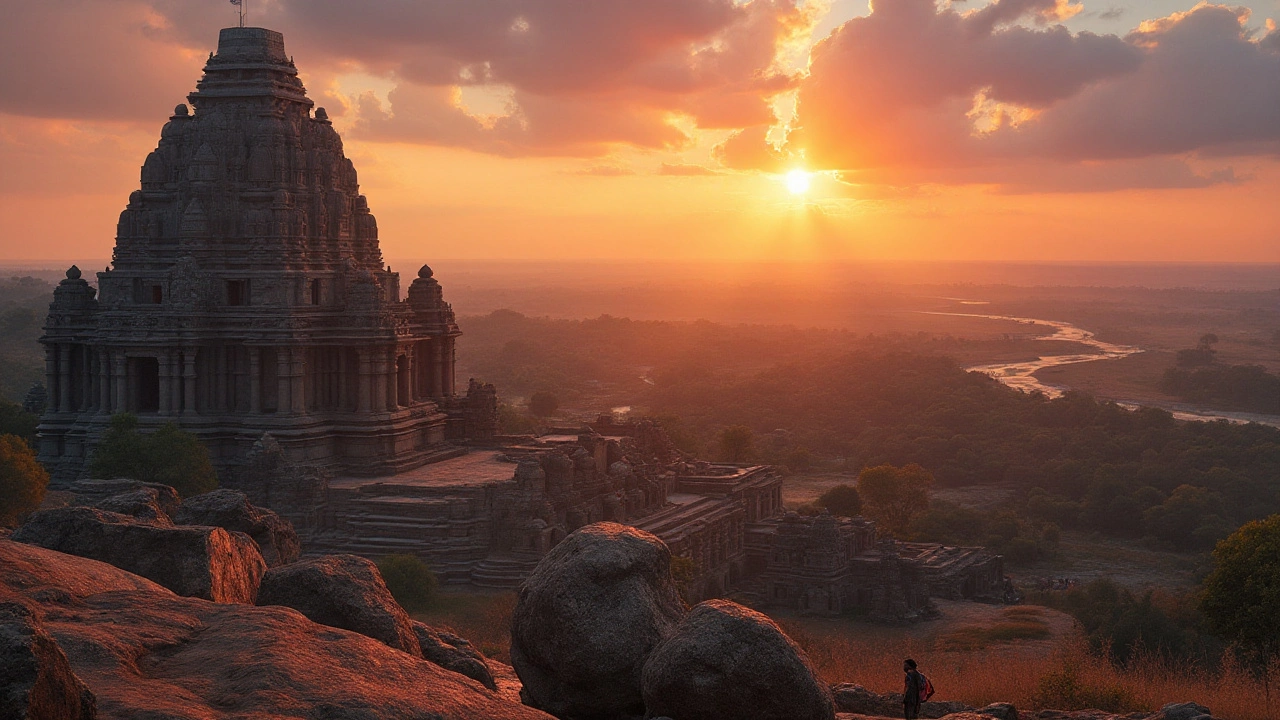SEARCH
Exploring India's Finest Heritage Sites: A Cultural Odyssey


India is a land where history breathes through its impressive structures, each narrating a different tale from its past. The country's heritage sites are more than just stone and mortar; they are vibrant storytellers of epochs gone by. Embarking on a journey through these sites is to step into a world where ancient empires once thrived, where art and architecture flourished in their many forms.
From the iconic silhouette of the Taj Mahal standing as a symbol of everlasting love to the sprawling city of ruins in Hampi that whispers the saga of bygone civilizations, India's heritage attractions are as diverse as they are enchanting. This article invites you to explore some of the most profound examples of architectural marvels and cultural richness that India's heritage sites offer.
- The Magnificence of the Taj Mahal
- Jaipur's Crown Jewel: Amer Fort
- The Spiritual Vibes of Varanasi
- The Ancient Ruins of Hampi
- Kaziranga National Park: A Heritage of Nature
- Tips for Visiting India's Heritage Sites
The Magnificence of the Taj Mahal
The Taj Mahal, with its domed roof shimmering in the golden light of dawn, stands unparalleled as one of India's most iconic heritage sites. This marble mausoleum, commissioned by the Mughal Emperor Shah Jahan in 1632, is a testament to undying love, dedicated to his beloved wife Mumtaz Mahal. The grandeur of the Taj Mahal goes beyond its architectural symmetry; it embodies the pinnacle of Mughal architecture, a style that fuses elements from Islamic, Persian, Ottoman Turkish, and Indian architectural styles.
As you gaze upon the Taj Mahal's white marble that seemingly changes color throughout the day, it's easy to become mesmerized by its enchanting beauty. This UNESCO World Heritage Site attracts millions of visitors annually, each drawn by its ethereal charm. The exquisite craftsmanship visible in the inlay work, known as 'Pietra Dura', is remarkable with its intricate floral designs made from precious stones like jasper, jade, and turquoise. As Rabindranath Tagore once wrote,
"The Taj Mahal rises above the banks of the river like a solitary tear suspended on the cheek of time."His words capture the emotion that the monument evokes in the hearts of those who visit.
The Taj Mahal is more than just a monument; it is an epitome of historical significance and cultural heritage. Its construction led to innovations in the use of marble and sandstone, paving the path for future architectural projects in India. The surrounding gardens, inspired by the Persian 'Paradise Garden', are meticulously designed to be an integral part of the site, emphasizing balance and harmony. Designed to represent paradise on earth, these gardens enhance the serenity and majestic aura that envelops the Taj Mahal.
One fascinating aspect of the Taj Mahal is the meticulous symmetry in its design, presenting a mirror-like reflection along the central water channel, enhancing the site's splendor. The four minarets delicately angled outward, a masterstroke of engineering intended to prevent damage in the event of an earthquake, frame the tomb, showcasing the Mughals' foresight and architectural prowess. The Taj Mahal not only exemplifies the beauty of Mughal architecture but also holds a mirror to the era's socio-political culture. The mausoleum reveals insights into the lavish lifestyle of the Mughal court and their deep appreciation for grandeur in art and architecture.
If you plan to visit the Taj Mahal, consider attending at sunrise or sunset when the play of light transforms its atmosphere. It's advisable to bring a pair of good walking shoes, as the tour involves a fair bit of walking. Don't forget to explore the nearby Agra Fort, another majestic counterpart that tells tales of the region's rich history. Visiting such heritage sites is a step back in time, a journey that enriches one's understanding of India's multifaceted history.
Jaipur's Crown Jewel: Amer Fort
Set against the picturesque backdrop of the Aravalli Hills, Amer Fort stands imposingly over the city of Jaipur, a shining piece of Rajasthan's rich historical tapestry. Built in the late 16th century by Raja Man Singh, this stunning fort is an exceptional example of Rajput architecture with a blend of Hindu and Mughal influences. As one strolls through its grand courtyards, intricate carvings, and opulent halls, it's easy to imagine the royal processionals that once graced these corridors. Visitors are often mesmerized by the fort's architectural brilliance, notably the Sheesh Mahal or the 'Mirror Palace'. This room is celebrated for its intricate mirror work, where even a single ray of light illuminates the entire space magnificently. It's not merely a structure but a symbol of the artistic creativity that thrived in that era.
The Amer Fort is not only an exemplary display of architectural prowess but also home to many fascinating tales from its past. Notably, it houses the Diwan-e-Aam, the public audience hall, and the Diwan-e-Khas, the hall for private audiences. The fort reflects not just the grandeur of its rulers but the strategic importance it held. High walls, watchtowers, and insurmountable gates echo the might of the Rajput warriors. As part of India's UNESCO world heritage sites, Amer Fort is a testament to the dynamic history and power of the region. Many have been enchanted by its beauty and opulence, including writers and travelers from across the globe. As noted historian William Dalrymple once wrote,
'Roaming through the corridors of Amer Fort was like walking through a fantastical carved sandstone kaleidoscope.'This adds to the allure and romanticism of the fort, making it a sought-after destination for visitors.
For those planning to visit Amer Fort, understanding its layout could enhance the experience significantly. It's advised to start with the Suraj Pol, the sun gate, and proceed to the Jaleb Chowk, the main courtyard. From here, one can explore multiple attractions like the Jagat Shiromani Temple, known for its exquisite craftsmanship; and the underground tunnel, which connects the Amer Fort to the Jaigarh Fort, meant for safe passage during conflicts. Engaging in an elephant ride up to the fort's entrance is a unique way to begin the journey, providing an authentic royal experience. Travelers should also reserve some time for the light and sound show conducted in the evening, which beautifully recounts the fort's storied past. Amer Fort remains a jewel not just in Jaipur but in the heritage crown of India's cultural landmarks, drawing history enthusiasts and tourists alike to bask in its timeless splendor.

The Spiritual Vibes of Varanasi
Varanasi, often hailed as the spiritual capital of India, is a city that resonates with the echoes of history and spirituality. Perched on the banks of the sacred River Ganges, Varanasi, known as Kashi in ancient texts, holds a significant place in Hinduism. The city's spiritual aura is palpable in the air and reflective of its ancient roots, dating back to around 3,000 years. Walking through Varanasi might feel like stepping into another dimension where time stands still, and spirituality pervades every aspect of life. The Northern Indian city is adorned with countless temples, each standing as a testament to its glorious past and religious importance. The streets are bustling with sadhus, musicians, and pilgrims who flock to this divine destination, seeking solace and meaning against the backdrop of ancient traditions.
Recognized for its iconic ghats that line the Ganges riverfront, Varanasi is where life and death converge in a mystical embrace. The most famous of these, the Manikarnika Ghat, is a sacred place for cremation where the cycle of life and moksha, or liberation, is deeply felt. The vibrancy of life is just as intense at the morning Ganga Aarti, a ritual of lights performed with great devotion by priests. Evening Aartis turn into a spectacle of light and sound, drawing in believers and visitors alike into a shared moment of reverence. As one experiences this ceremony, it becomes apparent why Varanasi is mentioned as "the beating heart of India's spiritual movement." A frequent visitor might say,
"Varanasi doesn't merely tell the stories of gods and mortals, it echoes their eternal questions and answers."
For the wanderer seeking to experience the true culture of Varanasi, a walk down its narrow alleyways offers a different kind of enlightenment. These bustling bylanes are filled with vibrant bazars, selling everything from colorful textiles to ornate jewelry, lending the city an aura as lively as it is sacred. Here, travelers can indulge in the flavors of Varanasi street food like kachori and lassi, known for their unique taste profile, owing much to the cultural diversity that has thrived here for centuries. The city also hosts a number of spiritual festivals, notably Dev Deepawali, which sees the ghats come alive with thousands of lamps lighting up the night as a divine salute to the Ganges.
Adding to the spiritual exploration, Sarnath, located just a short trip from the city, offers another historic dimension to Varanasi's heritage. Known as the site where Buddha is said to have delivered his first sermon post-enlightenment, Sarnath remains a pivotal pilgrimage site for Buddhists from across the globe. The awe-inspiring Dhamek Stupa stands at the center, quietly narrating stories of the past while enveloping visitors in tranquility. Varanasi not only stands as a beacon of Hindu spirituality but also embraces the Buddhist faith with equal grace, weaving together a rich tapestry of India's spiritual heritage. To truly grasp the essence of India's cultural landmarks, a journey to Varanasi is indispensable.
The Ancient Ruins of Hampi
Among the intricate tapestry of India's heritage sites, Hampi stands as a poignant representation of the resplendent Vijayanagara Empire. Situated in the southern state of Karnataka, this sprawling UNESCO World Heritage Site is a fascinating tableau of stone monuments, temples, and awe-inspiring architecture. Once a bustling metropolis and the capital of an empire that rivaled those of Europe in its zenith, Hampi today draws visitors to its otherworldly landscape of boulders and ruins. The extraordinary Virupaksha Temple stands as a living religious center amidst these ruins, offering an unbroken devotional tradition that dates back to its founding in the seventh century. As you wander through the temple's grand corridors and intricately carved sanctums, it's easy to imagine the vitality and religious fervor that once suffused this sacred space.
Skirting the Tungabhadra River, this magnificent site is punctuated by a plethora of historical narratives captured in stone. The Vitthala Temple complex exemplifies the apex of Vijayanagara architecture, distinguished by its ornate stone chariot and musical columns which are said to produce melodic notes when struck. Despite the ravages of time, these ancient plinths resonate with the cultural and artistic brilliance of the era. As Mark Twain once remarked, "Hampi was larger than Rome and very beautiful to the sight," encapsulating the sheer magnificence of what must have been an architectural marvel. The Elephant Stables, with their impressive arched entrances and domed chambers, provide yet another glimpse into the opulence that characterized the empire's golden age. Walking amidst these ancient stones, one cannot help but be transported back in time, envisioning the grandeur of courtly processions and the clamorous bustle of marketplaces that once peppered the imperial city.
Beyond its storied monuments, Hampi offers a captivating blend of myth and history. Tied to the epic Hindu tome of the Ramayana, it is said to be the mythical Kishkindha, the realm of the monkey gods. This genesis story blankets the landscape with an air of sacred mystique. Visitors can also embark on a trek to the apex of Matanga Hill for a panoramic vista of the undulating terrain and the mesmerizing silhouette of crumbling edifices against the horizon. Here, the mysteries and antiquity of the ruins unfurl, promising moments of introspection and unfiltered wonder. The Archaeological Survey of India has also unearthed rich ceramic and architectural remnants, further unraveling the complexities of this ancient civilization. It's through these detailed excavations that the vibrant culture, sophisticated urban planning, and economic prowess of the Vijayanagara Empire are illuminated.
The timeless appeal of Hampi lies in its raw and untouched wilderness juxtaposed with the intricate artistry etched on every corner. Seasoned travelers and history buffs often recommend dedicating at least a couple of days to fully absorb the spellbinding allure of this historic landscape. Evening light baths the worn stonework in a golden hue, revealing shadows that dance across ancient carvings, bringing the figures to life with undulating movement. To make the most of your visit to this wondrous place, it is advisable to start early in the day when the weather is cooler and the air is still laced with the melody of awakening nature. Cultural landmarks in India like Hampi offer a rare opportunity to step back into history and experience the legacy that has shaped one of the world's oldest civilizations.

Kaziranga National Park: A Heritage of Nature
Nestled in the heart of Assam, Kaziranga National Park stands as a testament to the abundant biodiversity that defines the Indian subcontinent. Recognized as a UNESCO World Heritage Site, this sprawling sanctuary is one of the last bastions for the endangered Indian one-horned rhinoceros, a species that has become emblematic of conservation success in India. Stretching over an area of 430 square kilometers, Kaziranga's landscape is an awe-inspiring tapestry of tall grasslands, dense tropical forests, and meandering rivers, housing an astonishing range of flora and fauna.
The park's diversity extends beyond its famous rhinoceroses. It's a wildlife enthusiast’s paradise, where one can also encounter the majestic Bengal tiger, the playful yet elusive river dolphins, and a vibrant array of bird species, making it a birdwatcher's haven. Kaziranga is renowned not just for its wildlife but also for its role in conservation. Its management practices have been hailed globally as models of how protected areas in developing countries can achieve sustainable conservation outcomes. As Dr. George Schaller, a prominent wildlife biologist, once remarked,
"Kaziranga is an exemplar of how community partnership is key to preserving nature's treasures."
Exploring Kaziranga is an experience brimming with wonder and education. Safaris offer close encounters with the park's wildlife, often rewarding visitors with sightings of herds of elephants roaming freely or the more elusive species like leopards. The park is also crisscrossed by several water bodies, making boat rides along these serene waters a cherry-topped adventure. The mystic landscapes immortalize themselves in photographs, and these scenes often find a permanent nook in the travelers' memory.
Planning a visit to Kaziranga National Park entails crafting an itinerary that balances exploration with relaxation. The best time to visit the park is between November and April, as the monsoons recess and the flora breathes anew with verdant glory. While the wildlife is the main attraction, those interested in local culture can venture to the nearby villages to experience Assamese traditions, art, and cuisine. Exploring the surrounding communities enriches one's understanding of how local cultures harmonize with their environments.
Key Conservation Successes
One of the key conservation triumphs of Kaziranga National Park is its remarkable recovery of the rhino population. According to the latest surveys, the park houses over 2,200 one-horned rhinos, a staggering recovery from just a handful left a century ago. This success is attributed to rigorous anti-poaching efforts and collaboration between park authorities, local communities, and international conservation bodies. The synergy between stakeholders involved has ensured no rhino is left unguarded, and the technological integration through monitoring and surveillance adds an extra layer of protection. The park's landscape is dynamic, with nature's order reigning supreme. This balance between wildlife and people is a cornerstone of Kaziranga's identity, making it a model for conservation worldwide.
Tips for Visiting India's Heritage Sites
Venturing into the heart of India to experience its heritage sites is an adventure steeped in culture and history. As you plan your visit, consider these tips to make the most of your journey through India's cultural jewels. The first thing to remember is that each site possesses a unique historical context, and understanding this context enhances the richness of your experience. Many sites, like the iconic Taj Mahal or the sprawling Hampi ruins, are layered with stories that reflect the grandeur and tragedy of bygone eras. It’s wise to read up on the history before your visit or hire a local guide who can bring these tales to life.
Next, dress comfortably and appropriately. Many of the heritage sites double as active religious spaces, requiring modest attire. Lightweight and breathable clothing will help combat the often hot and humid climate you’ll encounter across much of India. Keep a hat and sunscreen handy to protect yourself from the sun while you explore open spaces like the vast courtyards of the Amer Fort in Jaipur. Remember, these sites can get crowded, especially during peak tourist seasons, so planning your visit during off-peak times can provide a more intimate experience.
When visiting sites like Varanasi or the serene temples scattered around the country, be prepared for sensory stimulation. The vibrant atmosphere, filled with the scent of incense, the sound of temple bells, and the sight of people from all walks of life, can be overwhelming but rewarding. To truly appreciate these moments, slow down and allow yourself to absorb the surroundings instead of rushing through the itinerary. A personal tip: spend some quiet moments alone at each site, just contemplating and embracing the historical weight surrounding you.
For keen photographers, India provides endless opportunities to capture stunning images. Be respectful when photographing people, especially in religious areas or during ceremonies, and always ask for permission first. Keep in mind that some sites, especially those physically fragile or sacred, may have restrictions on photography. It's essential to respect these restrictions to help preserve India's rich cultural landmarks for future generations. Carrying a compact, high-quality camera is often sufficient to capture both wide shots and intricate architectural details.
Finally, consider your environmental impact. India's UNESCO World Heritage Sites are treasures that hold significant cultural and historical value. Leave no trace by disposing of waste responsibly and avoiding any practices that may harm the environment. Support local communities by purchasing arts and crafts directly from artisans. This not only supports the local economy but also ensures you take home authentic souvenirs, like intricate textiles or handmade pottery, that come with their own stories.